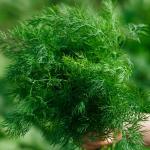Growing Dill
Anethum graveolens : Apiaceae / the umbelliferae family
| Jan | Feb | Mar | Apr | May | Jun | Jul | Aug | Sep | Oct | Nov | Dec |
|---|---|---|---|---|---|---|---|---|---|---|---|
| S | S | S | S | S | S | S | S | ||||
| T | T | T | T | T | T | T | T | ||||
| P | P | P | P | P | P | P | P |
(Best months for growing Dill in Australia - temperate regions)
- S = Plant undercover in seed trays
- T = Plant out (transplant) seedlings
- P = Sow seed
- Easy to grow. Sow in garden. Sow seed at a depth approximately three times the diameter of the seed. Best planted at soil temperatures between 50°F and 68°F.
- Space plants: 6 inches apart
- Harvest in 8-12 weeks. Use leaves before flowering.
- Compatible with (can grow beside): Cabbage, Coriander, Fennel, tomatoes, broccoli
Dill is best grown as an annual. It is easy to grow from seed and will produce wispy leaves growing on a single stem about 75 cm (30 in) high, which can be harvested about eight weeks after sowing. Once the plant will begins to produce flower heads, the leaf production will stop. Dill, like most herbs, grows best in the sun, but will tolerate afternoon shade. Dill grows up to 1 m (36 in) tall, so plant it in the back of your flower, vegetable or herb garden. Sow seeds close together. This will allow the plants, which blow over easily, to support each other.
If you want to use dill seeds, let the seedheads develop and dry completely, then cut them and hang them upside down by the stems in a paper bag. The seeds will dry and fall into the bag. They can then be stored in a glass jar.
Repeat sow for a regular supply of leaves.
Culinary hints - cooking and eating Dill
Dill leaves can be used fresh or dried in salads, meats, vegetable dishes and soups.
Freshly cut leaves enhance the flavour of dips, herb butter, soups, salads, fish dishes, and salads.
Both the flowering heads and seeds are used in flavoured vinegars and oils.
Used whole or ground, the seeds add zest to bread, cheese, and salad dressing.


Your comments and tips